The history of the Pacific Islands Office (PIO) starts with recollections from Gene Suhr and Les Wierson describing their first ventures to Hawaii in the late 1960s. It was Les, who leveraged a cold call from Norman Saito of Norman Saito Engineers of Maui, who, with Norman, won the Kihei Project, the first significant contract in Hawaii and the stepping stone to become the firm’s “Bridge to the Pacific Rim.”
The 1970s saw Les, Joe Worth, Tony Groh, and Gordon Koblitz, in partnership with Norman Saito, implement the Kihei project. It was this work that Dann Madden used to leverage our presence in the Pacific Islands. The 1980s started with Dann opening an office on Maui that was manned by Don Marske, Mike Conway, Glenda Hayashi and many visitors from the mainland offices. The Maui office also hosted OMI’s Contract No. 1 managed by Bernie Miller, employee No. 3 of the new subsidiary. The Honolulu office was opened in mid 1980 where Jenni Wong, Bob Chuck, Maurice Kaya, and again more visitors from the West Coast and beyond joined the firm. The 1990s were years of restructuring led by Mike Kennedy, Bob Chuck, Paul Luersen, and Ross Kaneko.
Today, the 2000s represent the truly breakout years for the office. Led by Paul Luersen, Ross Kaneko, Dennis Peters, Pete Magallones, and more recently, Chris Williams, the office is now some 70 strong with annual billings of $24 million doing a wide variety of work throughout the Pacific Islands and Rim. The Honolulu office is now clearly the firm’s Bridge to the Pacific Rim.
In the beginning …
Gene Suhr recalling the firm’s first foray into Hawaii, circa late 1960s.
A good friend of CH2M, Bob Belt, who had been a planner working in Portland was one of the principals in the engineering firm of Belt, Collins & Associates (BCA) in Honolulu. Mostly through his efforts, CH2M joined with BCA to propose on a major wastewater project for the Sand Island STP. I went to Honolulu to write the proposal at BCA’s office. I recall that the first day I reported to their offices, I was dressed in a suit and tie. Bob Belt took me aside and handed me an aloha shirt and told me they didn’t “dress” on Fridays. Together we made what I thought was an impressive proposal. I particularly remember that we bound a flyleaf into the document that was a sheet of translucent vellum with a map of the islands and a quote from Mark Twain, ‘The loveliest fleet of Islands ever anchored in any ocean.’ Sid Lasswell came over for a few days to help put the finishing touches on the proposal.
One other fond memory about this effort reminds me of what a true gentleman Bob Belt was. When it was time to leave, he took my ticket to expedite things and noticed it was a coach class fare. He immediately said that that just wouldn’t do and bought me a new first class ticket. It was my first time in first class and I must admit Continental Airlines really made things nice up front.
Les Wierson recalls the firm’s first contract in Hawaii.
By the early ’70s the Portland office (PDX) had grown to the planned 100 employees. We were struggling to find new significant long-term clients. Boundaries limited our growth north, south and east. The office had no discipline core except planning. We did not have a western boundary.
In 1971 Normal Saito of Norman Saito and Associates called on Wierson to ask CH2M to partner with his firm on Maui. Saito’s firm was a small but well respected company. They did civil projects for the County of Maui and private clients. Norman’s wife was the Director of Public Works’ secretary for many years. After consulting with Sid Lasswell we agreed and sent qualifications to Norman. Sometime later (2-3 weeks) he called to tell us we had won one of the three projects (Lahaina) and to come as soon as possible. When I arrived we learned the project was Kihei, not Lahaina. Kihei at that time was a dusty strip of houses on a beautiful Pacific shoreline. I was somewhat disappointed, but later found this was the best of the projects. Saito did the sewers. CH2M did the pump stations, treatment plant, advanced waste treatment (AWT) for park irrigation and deep well injection for disposal – all cutting edge technology. Gordon Koblitz and Dick Humphrey took lead roles in delivering an award winning project. Joe Worth helped expand our work in Maui to include water supply to Kihei/Wailea and expansion of sewerage to the Japanese development in Wailea.
Being halfway across the Pacific we were tempted to look for other opportunities. The CH2M Board gave the okay for PDX to develop work in the Pacific Rim and the Seattle office (SEA) to explore western Canada and Alaska. (Clair Hill had an office in Anchorage). With Toray Engineering of Japan, we conducted pilot projects in AWT, ammonia stripping, etc. It never led to big projects, but it was a good learning exercise in working in foreign countries. The PDX office also worked in American Samoa and Guam. The Hawaii operations initiated early with the U.S. Pacific Fleet operations and other military branches.”
The 1970s
The Kihei Sewerage System started in 1971 with a study recommending a 3 million gallon per day (mgd) plant. During review, the size was increased to 4 mgd to accommodate serving the adjacent Wailea development. Gordon Koblitz/PDX and Joe Worth/CVO took lead roles in delivering the wastewater and water supply systems for the project.
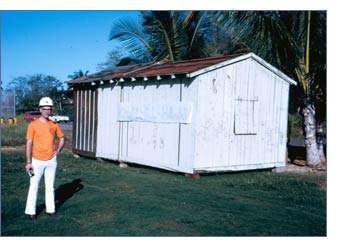
Design commenced in 1973 on a system that would stretch 7 miles from North Kihei to the entrance of Wailea. The system included 23 miles of pipe, seven pump stations, a complete-mix activated sludge treatment plant, effluent storage, partial tertiary filtration for 0.25 mgd for Kalama Park irrigation and an irrigation system for beneficial reuse of the remaining effluent to meet the no ocean discharge permit requirement.
Construction started in 1974 at a total cost of $10 million using only county and state funds. It was the largest public works project for Maui County to date. Construction challenges included the blasting and removal of 30,000 cubic yards (cy) of rock, placing 2,700 cy of concrete and dewatering issues with the caisson construction of the seven pump stations next to the ocean. The Kihei Project won the1976 Water and Wastes Engineering’s First Place Award for Engineering Excellence, as well as the First Place Award for the Hawaii Consulting Engineers Council.
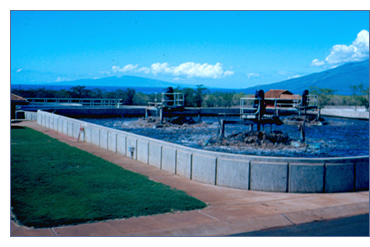
Other Hawaii work included support for Chung Dho Ahn in late 1974 for a facilities planning project for Kaneohe, Oahu; Waiehu Pump Station additional work with Warren Unemori in early 1975; Industrial Cost Recovery (ICR) study for Maui County in mid-1979; and an emergency pumping system and preliminary engineering study for Amfac’s Kaanapali, Maui STP in late 1979;
With our foot in the door, I handed the Pacific Island reins to Dann Madden/PDX. Dann leveraged our Maui presence to American Samoa, Guam, the Trust Territories, and other Hawaii work. Dann was very fond of the people in the islands and the island people were very fond of Dann.

The work in American Samoa was built largely on Dann’s relationship with Dan Stock, a U.S. Public Health Service officer who was on duty in American Samoa and the Trust Territories. We worked with Dan on several water and wastewater projects over the next several years. Dan eventually retired from the USPHS in 1983 and joined OMI as their Director of Technology. He later became the Director of Quality Assurance before retiring in 1985.
The work in Guam started with Juan C. Tenorio, a consultant on Guam and the Trust Territories. Later, Dann worked with John Duenas and Dan Swavely of Duenas & Swavely, a strong civil and planning consultant on Guam. This relationship led to several interesting water, wastewater, and power projects on Guam, Saipan, Truk, and Pohnpei.
The 1980s
Dann Madden, then the PDX Regional Manager and project manager for a major tunneled sewer interceptor for the Milwaukee Water Pollution Abatement Project, offered Don Marske a transfer from the Milwaukee office to Maui to manage an Operations Management Study of the Maui DPW Wastewater Management System. The study was to provide the entree for a physical presence in the islands.
The first office was pretty spartan – a bungalow behind the old Kahului Railroad Station – but a step up from the Kihei shack. Under the general tutelage of Dann Madden and our den mother Glenda Hayashi, the office started to grow and by the end of 1980 had several new faces including John Turner, Bob Pietersen, Ed Schmidt, John Wilson, all with OMI.
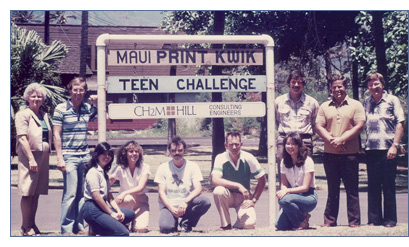
The Operations/Management Study was completed in early 1981. Other early 1980 work included Amfac’s 3.5-mgd Kaanapali STP in 1982 in joint effort with the Maui County 3.2-mgd Lahaina STP in association with Brock & Associates in early 1982; and the Molokai 0.3-mgd RBC STP for Kaunakakai in mid-1982. This new work resulted in several new task orders for the office – and a whole new set of visitors.
The staff included two outstanding summer interns from the local high schools – Diane Taniguchi (left) and Lynn Kawamura. Diane joined the firm after graduating from Cornell and then went to the City of Salem and is now the Director of Public Works for the City of Albany, Oregon. Lynn went on to graduate from Stanford where we lost track of her.
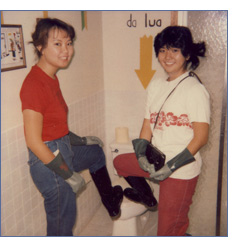
The first summer picnic gathering included the Operation & Maintenance, Inc. (OMI) crew including Bernie Miller/Maui project manager and Employee No. 3 of OMI; Bob Pietersen; and Ed Schmidt all with OMI. The Maui project was Contract No. 1 for OMI. The Maui contract was a real challenge for OMI. Bernie tells the story of an operator at the Kahului plant who he was continually trying to get to do more work. Eventually, in frustration, the operator came to Bernie’s office and told him, “Bernie, I work for the County. I’m 44 years old and haven’t worked a hard day in my life, and I’m not about to start.” But Bernie prevailed. Eassie Miller, a Maui local and OMI alumna, is now the Maui Director of Water Supply and Jeff Eng, another OMI alumna, is the current Wastewater Division Manager.
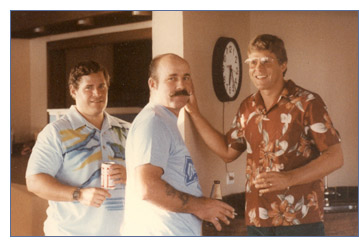
The 1981 Christmas Party featured Bernie Miller as the “local” da kine Santa. We had several guests that year including Nancy Tuor/PDX, Randy Naef/CVO; Ralph Hayashi and Dann Madden/PDX; and Gary/CVO and Marla Fries.
In the summer of 1982, Diane contracted typhus when Mike Conway sent her down a pump station where she got bit by a flea. The most debilitating effect, according to Diane, was she couldn’t touch alcohol for a year! 1982 also featured the South Pacific Conference in Pago Pago, American Samoa. This was a big deal – akin to a United Nations of the South Pacific. It offered an opportunity to learn about the issues of the island nations and cement existing client relationships and build new ones.
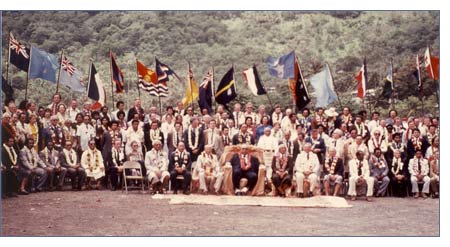
The 1982 Christmas Party included special guests Gene and Babs Suhr from CVO, Bill Johnson/PDX, and another visit from that special “local” good sport Santa, Bernie Miller.

In 1984 the office hosted an Alternative Water Sources in the Pacific seminar, a major marketing effort to introduce the firm and its capabilities to the clients of Hawaii and the South Pacific. Preparation for the seminar was truly a family affair with both Don and his wife Joan and Mike Conway and his wife Jo engaged in the presentation and hosting.
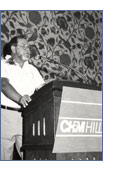
The seminar was keynoted by Gene Suhr with several other distinguished guest and expert presentations by Bill Byers/CVO, Peter Binney/DEN, Bob Charley/RDD, Maui Mayor Hannibal Tavares; Bob Chuck, Director State Water Resources; Kees Corsmitt/PDX, and Jim Mavis/SEA. The program was well attended by a wide range of clients including Bill Haines, Maui Director of Water Supply; Kazu Hayashida, then Director Honolulu Board of Water Supply; Ralph Masuda/Maui County; Art Henderson, President Maui Electric; and Manabu Tagomori Deputy Director of State Water Resources Board.
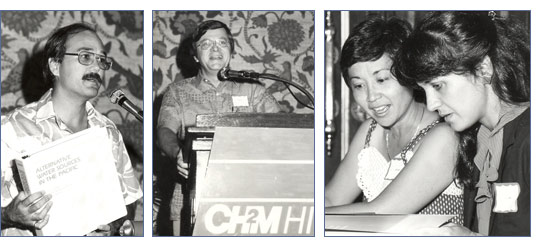
It wasn’t long before we got a return for the effort. A sampling included a very interesting desalination research facility study for the State Department of Land and Natural Resources, and a small desalination project for the Corps of Engineers (COE) for Kwajalein (Stu Davis/PDX). This was a two-stage vacuum flash evaporation system using waste heat from the diesel electric generators on the island – may have been the first desalting project for the firm using that technology. The office was also awarded a computer modeling of the Honolulu water system led by Russ Stepp, now the President and CEO of R.W. Beck in Seattle, and Ernest Lau for the Honolulu Board of Water Supply. Another interesting assignment was the commodities (papaya) irradiation project led by Jack Savinski and Scott Ahlstrom/ABQ. Unfortunately, the anti-irradiation people picketed the grocery stores on the West Coast bringing a quick end to the project.
The signature project of this period was the design-build Schofield Barracks air stripping water treatment. The office received a very nice commendation from the COE for a job well done. Kudos goes out to Tom McBriar/SEA, PM; Bob Schilling/SEA, mechanical design; and Bill Byers/CVO, process engineer.
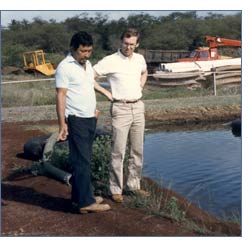
Gordon Koblitz/PDX kicked off 1985 with the construction of the Kaunakai, Molokai wastewater treatment facility with Bill Mori, Molokai’s Plant Operator. Today the facility is home to several endangered wetland birds making it an “awesome birding” site for water birds, endangered coots, endangered stilts, the Pacific Golden Plover, Wandering Tattler, Bristle-thighed Curlew and more.
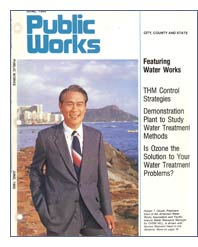
1985 also brought Bob Chuck into the Honolulu office and in 1986 he was elected President of the American Water Works Association and was featured on the cover of Public Works magazine. Bob’s introduction to the firm had some interesting history. It seems that Bob was a classmate of Dolores Beazel who was, at the time, the .70s Discipline Assistant. On one of his many trips to the Islands and before Bob’s hiring, Dolores asked Gene to take Bob and his wife to dinner. In Honolulu, Babs Suhr dutifully attempted to telephone Bob. At the time, Bob was being besieged with phone calls from salesmen. Somehow he decided that Babs was an encyclopedia salesperson and somewhat forcibly ended the nascent invitation call. Only later, at a water resources seminar where he and Gene were program speakers did he find out, to his chagrin, that Babs wasn’t a salesman for Brittanica! But the story doesn’t end here. Shortly after being hired, Bob visited the CVO office so that he could be introduced to the various disciplines that would be supporting work in the Pacific Islands. Now Gene had been harboring a desire for “revenge” over the phone-call incident and saw this visit as a golden opportunity! After effusively welcoming Bob, Gene expressed a certain “bewilderment” about the Hawaiian language and its prolific use of vowels which made for somewhat difficult pronunciation. As an example, Gene wrote on his blackboard: Pi Pe Li Ne and asked Bob how that would be pronounced in the Hawaiian language. Bob took the bait, hook, line and sinker and replied “Why pip-a-li-ni of course. Gene replied with a smile, “That’s funny, on the mainland we say pipeline.”
In early 1988, responding to low profitability pressures from Corporate, Mike Kennedy issued an internal memo announcing a consolidation of PIO operations into the PDX Region. This included the transfer of Don to Los Angeles, the appointment of Maurice Kaya as office manager, and a reduction of other staff to match workload. This announcement was followed by a decision to close the office which resulted in the resignation of Maurice Kaya, Jenni Wong moving to Gray, Bills and Hong, and the majority of the remaining staff moving to other opportunities.
Despite this turn of events, Bob Chuck, Dick Ivey, and Mike Kennedy continued to fight for the “project office.” The fight was aided by the fact that the office still had several planning contracts with several major clients including Hawaiian Electric, Hawaii Electric and Light Company, Corps of Engineers, State of Hawaii, and Herbert Horita and Jack Myers, local developers. To fulfill the contract obligations to these valued clients, Dick Ivey was instrumental in hiring Al Lyman, transferring Paul Luersen from SEA, and engaging several TDYs from other offices to complete the work. This work allowed the office to stay viable. The announcement to close the office was never published, and Bob Chuck was named to replace Maurice as the PIO Manager. Whew! Close call.
The 1990s
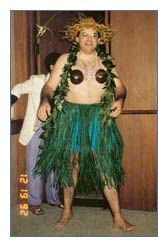
From 1988 to the early ’90s, the PIO office continued to serve the Honolulu clients below the corporate horizon. To get their heads above water, Mike Kennedy made a deal with Paul Luersen and the HNL team: “If you make Plan (’92), I will dance the hula.” They made Plan! In retrospect, Mike’s challenge was the single most critical event that forever changed the fortunes of the PIO. And the rest is history.
The office continued to thrive through the mid ’90s serving primarily Hawaiian Electric, Bishop and Campbell Estates, and Honolulu Board of Water Supply. By 1997 the work grew to the point where the 1585 Kapiolani office had to expand to the 14th floor. The Open House was a gala affair with many friends and clients joining in the celebration.
2000 to Today
The office has grown dramatically over the past decade. In 1998, the total revenue was just over $6 million with a staff of 15. Over the next couple of years the growth was slow but steady while quietly expanding markets and skill sets to include environmental work with the Air Force Center for Engineering and the Environment (AFCEE). During this period, the office also renewed its water and wastewater work and rebuilt its staff.
The office really took off in 2002 when AFCEE started a new program that resulted in several design-build renovation and repair projects on Air Force installations in Asia. Staff grew from 20 to about 40 and gross billings ballooned to $18 million. This flywheel allowed the office to enter and expand in other markets including GIS, design-build in water and wastewater, and transportation.
Today the little ole office has grown to over 70 full-time people doing work all over Hawaii and throughout Asia-Pacific including Johnston Atoll and Korea. Looks like the office has achieved the strategic goal of the early managers: Become the Gateway to the Pacific Rim. Thanks go out to Les Wierson, Dann Madden, Dick Ivey, Bob Chuck, Mike Kennedy, and Paul Luersen for keeping the dream alive.
In June, 2008, Don returned to Honolulu to visit with Paul Luersen and Bob Chuck to find that they recently moved downtown to 1132 Bishop Street. Yes, Bob still comes to the office almost every day. He enjoys mentoring the young people in the ways of client relationships, and yes, he still shoots his age (84) in golf.
Postscript
I had the privilege and honor to manage the operations of the Pacific Islands Office from 1980 to 1988. From the beginning, I knew it was going to be a special time for my family, several members of the firm, and myself.
The assignment allowed Joan to return to her home and family and it allowed our children to get to know their grandparents, uncles, aunts, and cousins. It was a short 8 years, but the impact of that time continues to influence their lives today. The PIO has also allowed several members of the firm to experience the magic of Hawaii. For some it may have been a short project assignment, for others it meant an extended visit for them and their family. For all of them, I’m sure the experience also remains a very special memory. For me, the assignment was a growing experience. In retrospect, there are some things I wish I could do over again; but overall, I truly enjoyed the assignment, especially sharing the work with our many visitors to the islands.
The foregoing is an excerpt from a larger photo journal that was drawn from a scrapbook that I kept. However, the story of the office would not be complete if it were not for the contributions of Gene Suhr, Les Wierson, Gordon Koblitz, Mike Conway, Bernie Miller, Bob Chuck, Paul Luersen, and Stu Davis. To all, Thank You.
If anybody is interested in seeing the unabridged version of the history, please feel free to drop me a note at donmarske@gmail.com.
– Don Marske, January, 2009

